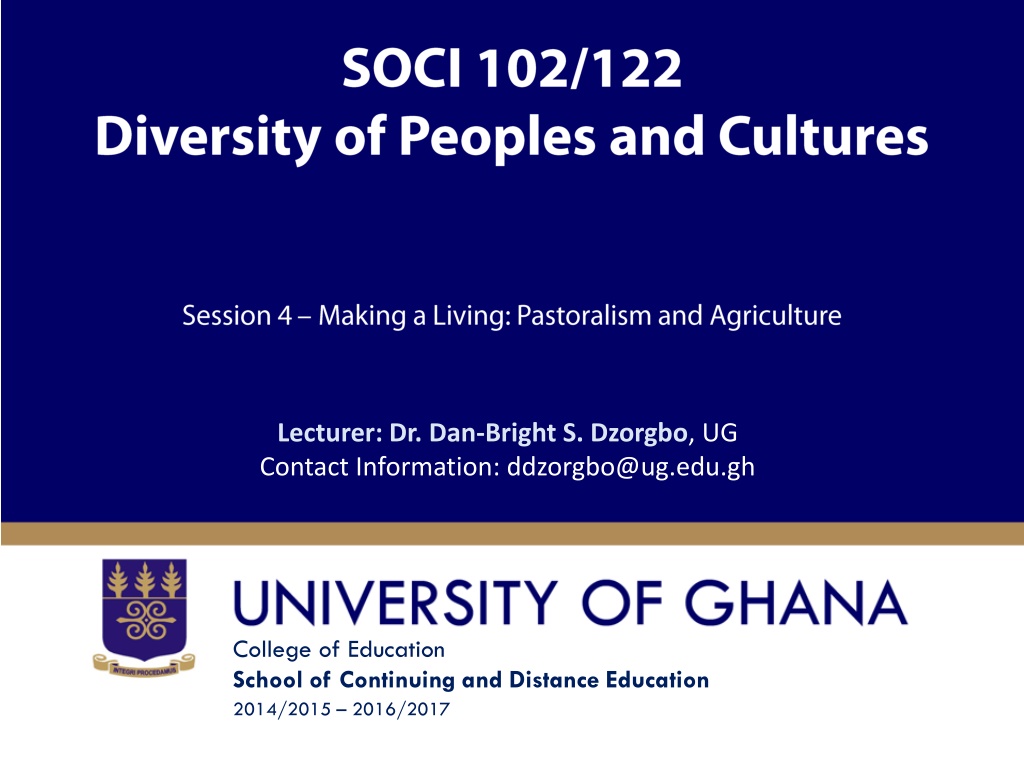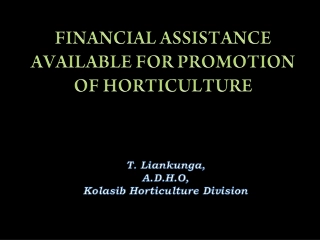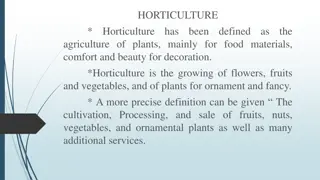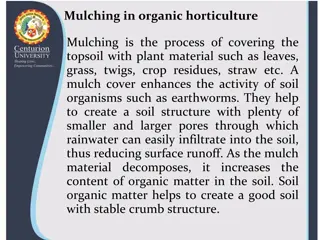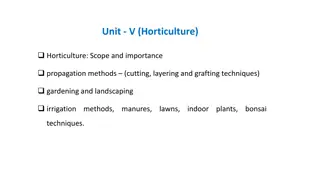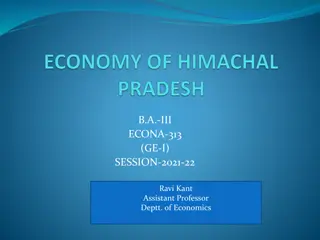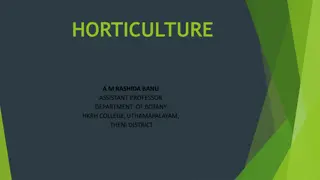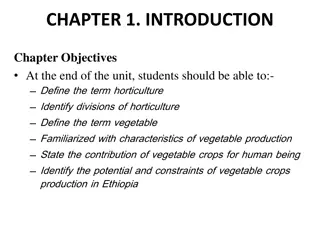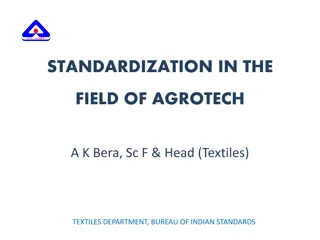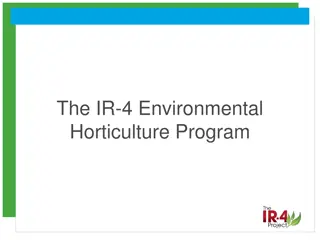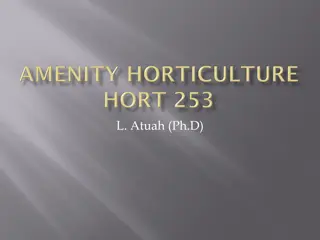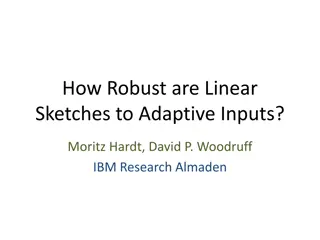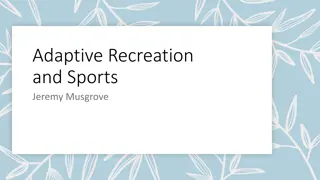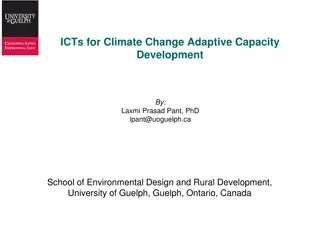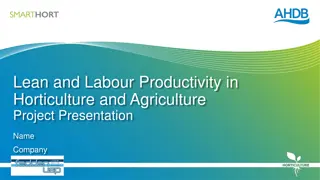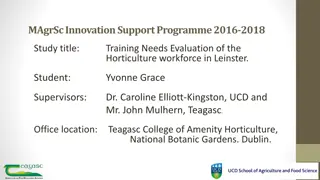Understanding Horticulture and Agriculture: Adaptive Strategies in Human History
This article delves into the development of adaptive mechanisms in human history, focusing on horticulture and agriculture as key strategies. It explains the differences between horticulture and agriculture, explores the concept of cultivation continuum, and discusses pastoralism as an adaptive strategy. Through this session, readers will gain insights into how humans evolved from foraging to more efficient cultivation practices, highlighting the significance of these adaptive strategies in shaping societies.
Download Presentation

Please find below an Image/Link to download the presentation.
The content on the website is provided AS IS for your information and personal use only. It may not be sold, licensed, or shared on other websites without obtaining consent from the author. Download presentation by click this link. If you encounter any issues during the download, it is possible that the publisher has removed the file from their server.
E N D
Presentation Transcript
Lecturer: Dr. Dan-Bright S. Dzorgbo, UG Contact Information: ddzorgbo@ug.edu.gh College of Education School of Continuing and Distance Education 2014/2015 2016/2017
Session Overview Introduction This section is sequel to the preceding one and examines the additional and more superior forms of adaptive mechanisms humans developed in the course of their history, namely cultivation (which can be further distinguished into horticulture & agriculture) and also pastoralism. Objectives At the end of the session, the student will be able to: Examine horticulture and agriculture as adaptive strategies Distinguish how agriculture differs from horticulture Explain the concept of cultivation continuum Examine pastoralism as adaptive strategy Distinguish between two types of pastoralism Slide 2 Dr. Dan-Bright S. Dzorgbo, Sociology Dept. UG
Session Outline The key topics to be covered in the session are as follows: Topic One : Horticulture Topic Two : Agriculture Topic Three: The Cultivation Continuum Topic Four: Pastoralism Slide 3 Dr. Dan-Bright S. Dzorgbo, Sociology Dept. UG
Reading List Assimeng, M. (1999), Social Structure of Ghana, Tema, Ghana Publishing Corporation. Kottak, C. P. (2004), Cultural Anthropology, Boston, McGraw Hill Corporation. Kottak, C. P. (2004), Anthropology: The Exploration of Human Diversity, Boston, McGraw Hill Corporation. Nolan, P. & G. Lenski, (2004 or any of the newer editions), Human Societies: An introduction to macrosociology, Boulder Paradigm Publishers. Nukunya, G. K. (2006), Tradition and change in Ghana: An introduction to sociology, Accra, Ghana University Press. Sanderson, S. K. & A. S. Alderson (2005 or its newer editions), World societies: the evolution of human life, Boston, Pearson Education Inc. Slide 4 Dr. Dan-Bright S. Dzorgbo, Sociology Dept. UG
Topic One: Horticulture Horticulture or shifting cultivation as known in many discussions on the Third World and particularly African agricultural systems, is the perhaps first attempt by humans to cultivate crops. It is an improvement over foraging or hunting and gathering adaptive strategies considered in the preceding session. Creative and clever as humans are they probably saw the foolishness of time consuming and labourous foraging was and also perhaps also saw that the seeds of fruits and edible roots, plants, etc. could be grown and later consumed so they began the cultivation. Given the low level of technological development or material culture, horticulture makes no intensive use of the factors of production: land, labour, capital and technology or machines Slide 5 Dr. Dan-Bright S. Dzorgbo, Sociology Dept. UG
Topic One: Horticulture (contd) Horticulturalists rather make use of simple tools, such as digging sticks, hoes, mattocks, machetes/cutlasses, to undertake their cultivation Their farming lands are not cultivated permanently They are likely not to own the land privately but communally. Fields are cultivated usually once or twice and are left to lie fallow for varying periods of time before being cultivated again, depending on the fertility and invading weeds Slide 6 Dr. Dan-Bright S. Dzorgbo, Sociology Dept. UG
Topic One: Horticulture (contd) Horticulture is also known as shifting cultivation meaning cultivators shift from plot to plot. Horticulturalists unlike foragers who move from place to place, are more likely to have permanent settlements and so are able to build communities of about 100 to 200 even more members and usually have a clearly identifiable social and political/governing systems. The basic technique of cultivation of horticulturalist is called slash and burn. The land is cleared by cutting down forests, grasses and trees (slash) and letting them dry and then burning them. Although burning may result in the destruction of some living organisms that provide the field nutrients, the ashes generated as a result the burning generate potassium that also serve as fertilizer Little or no fertilizers are used Cultivation usually is rain-fed and is meant mainly for subsistence. Horticulturalists also continue to engage in hunting and gathering activities Societies that are predominantly horticultural are increasingly incorporating agriculture as an adaptive strategy Slide 7 Dr. Dan-Bright S. Dzorgbo, Sociology Dept. UG
Topic One: Horticulture (contd) They make use of simple tools such as hoes, cutlass, digging sticks, etc. The practice slash and burn and shifting cultivation Mainly driven by human labour Little use of fertilizer, improved seeds, etc. Mainly for subsistence Slide 8 Dr. Dan-Bright S. Dzorgbo, Sociology Dept. UG
Topic Two: Agriculture Agriculture is a term used to describe a cultivation system that uses more labour, capital, technology and land more permanently or continuously than horticulture. In some agricultural systems, the less demand for labour because of the use of more machinery and technology, for example agriculture in the developed countries such the US, Canada, Britain Australia, Japan, etc. In some systems more labour is demanded because of the use of domesticated, irrigation and terracing of hills and mountainous land In the above context, animals are use to plow and harrow fields, to trample pre- tilled fields and mixing fields with water, as a means of transporting harvests, and their droppings as manure organic manure. Buffalos, donkeys, cattle, etc. Unlike horticulturalists, agriculturalists often use irrigation facilities from streams, rivers, ponds, springs to cultivate crops year after year. They are likely to make use of chemical manure and so fields can be cultivated on permanent basis. Cultivation yields per land and labour are usually higher for agriculturalists than horticulturalists. Agriculture is thus more dependable than horticulture. Slide 9 Dr. Dan-Bright S. Dzorgbo, Sociology Dept. UG
Topic Three: The Cultivation Continuum Because these adaptive strategies seem to follow each other and do exist in varying degrees in societies that are not industrialized or advanced economies we conceive of them as existing along a cultivation continuum. The world continuum denotes something starting from one point and ending on another Horticultural systems stand at one point low labour, shifting farming fields, using less scientific techniques and less machines, etc. developing and agricultural systems at the other point with permanent fields, use of irrigation facilities and more scientific knowledge and technology. Slide 10 Dr. Dan-Bright S. Dzorgbo, Sociology Dept. UG
Topic Four: Pastoralism Pastoralism exist when there the domestication of and rearing of animals such as cattle, sheep, goats, camels, yak, etc. as major economic activity to survive In Pastoralism animals and humans engage in symbiotic relationships. Humans protect these animals to ensure their safety, health and reproduction and they depend on them for food (milk, dairy products such as yogurt, butter, chees), meat and other products such as leather Pastoralists need large fields to rear their animals and are often mobile like horticulturalists looking for green pastures for their animals Slide 11 Dr. Dan-Bright S. Dzorgbo, Sociology Dept. UG
Topic Four: Pastoralism (contd) Mobility is a characteristic of pastoralism. Animals must be moved around but two types of pastoralism are often distinguished based on the movement of animals: (i) pastoral nomadism and (ii) transhumance Pastoral nomadism: this is where the entire group of herders men, women and children move with their animals throughout the year. During the treks pastoral nomads trade their animals for food and other valuables. Transhumance nomads: this is where part of the group usually the males move with the animals to look for pasture while most people stay at home. Transhumants also cultivate crops as well and need not to depend solely on their animals for their survival Slide 12 Dr. Dan-Bright S. Dzorgbo, Sociology Dept. UG
Conclusion In this session we have discussed two types of cultivation strategies. They are: Horticulture and agriculture We argued that many non-industrialized societies have these two cultivation strategies We argued that we should regard both horticulture and agriculture as existing along a cultivation continuum Pastoralism is the rearing of animals as a major economic activity We distinguished two types of pastoralism: pastoral nomadism (i.e. rearing of animals and moving with them) and transhumance (having permanent settlements and rearing animals as major activity but also cultivating crops as adjunct activity) Slide 13 Dr. Dan-Bright S. Dzorgbo, Sociology Dept. UG
